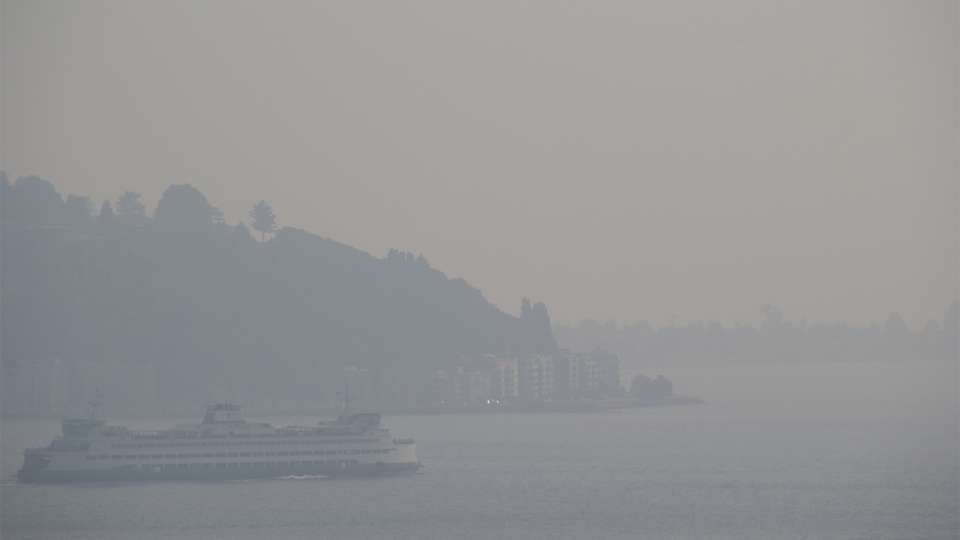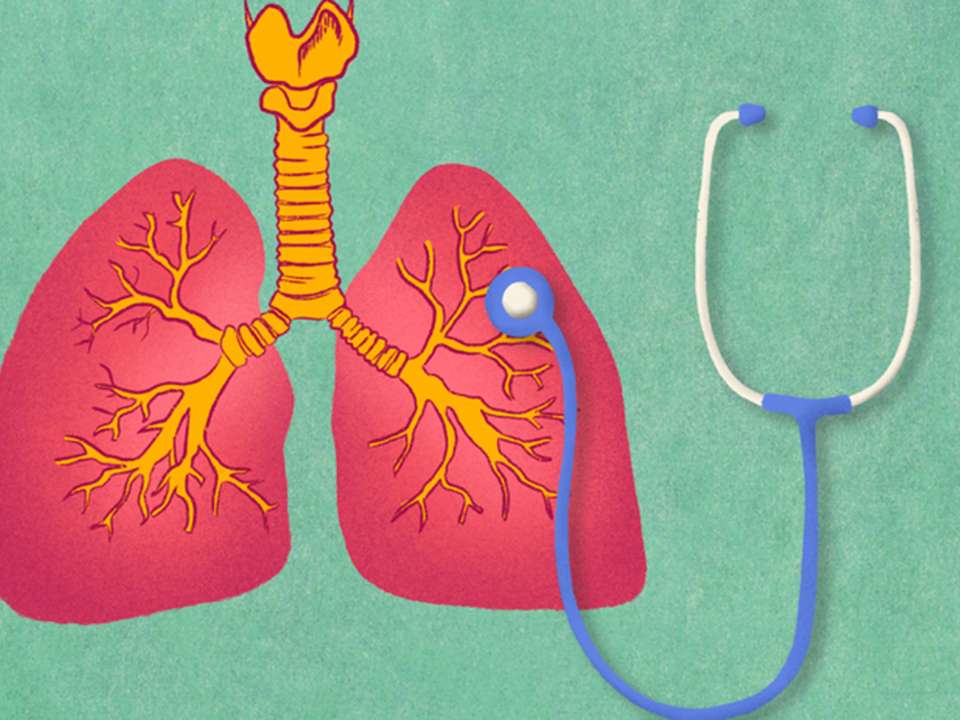
If you lived in the Pacific Northwest last summer, you already know what it’s like when forest fire smoke becomes a part of your day to day. There’s that whole weird apocalyptic feeling, but what about its health effects?
We took our questions to Joel Kaufman, M.D., M.P.H., a physician, epidemiologist and specialist in occupational and environmental medicine, who practices at both UW Medical Center—Roosevelt and Harborview Medical Center.
Q: How do you know when you need to be concerned about the levels of forest fire smoke in the air?
A: When the haze in the air obscures your ability to see the mountains—or even the buildings across town—like last summer in the Seattle area, that’s when you need to be concerned. It turns out that this haze is associated with some very small particles—known as fine particulate matter—being in the air.
The individual particles are actually so small that you can’t even see them. But when there are a lot of them, that’s when you begin to see the haze.
Q: What is in particulate matter?
A: Particulate matter is a mixture of microscopic solids and liquid droplets suspended in air. It includes acids, organic chemicals, metals, soil and dust particles, and fragments of pollen or mold spores.
But it’s the size of the particles that is of the most concern because smaller-sized particles are linked to the potential to cause health problems. There are bigger particles, but we worry less about those.
Q: What’s so bad about the small particles in forest fire haze?
A: Those very small particles—less than 2.5 microns or a tiny fraction of the width of a human hair—can be inhaled deeply into the lungs.
They’re so small they can get into the very narrowest passages. There is reason to believe that some of them can even be passed into your circulation.
Q: What are the health effects of inhaling smoke from forest fires?
A: Researchers have found that long-term exposure (over years) to air pollution increases the risk of heart and lung diseases including chronic obstructive pulmonary disease (COPD) and asthma. It also accelerates the process of the narrowing and hardening of the arteries known as atherosclerosis, the main cause of heart attacks and strokes. But there’s a significant difference between long-term exposure and the short-term exposure that occurs in a discrete event such as a forest fire.
Healthy people don’t need to worry so much about the short-term exposures. Living somewhere with consistently bad air quality ratings is far worse for you than the short-term exposures that we tend to experience in the Pacific Northwest.
For people with pre-existing health issues though, short-term exposure can aggravate many conditions. People who have asthma, COPD, decreased lung function, or other lung and heart diseases need to avoid smoke, which can exacerbate these conditions.
Q: Is there a reliable online resource where you can check air quality levels?
A: AirNow is a government resource that provides reliable information on air quality. It integrates data on five different health-related pollutants—including the particulate matter that you get from a forest fire—into a numeric score. The higher the score, the more air pollution and the greater the health concern.
Those scores are ranked by category, ranging from good to hazardous. They also color-code the categories—from green for good to maroon for bad—which is an easy way to tell at a glance what the air quality is like on any given day.
Puget Sound Clean Air Agency is another great local resource.
Q: Can a mask protect you from forest fire smoke? If so, what kind of mask and under what conditions would you wear it?
A: Well first of all, it’s unlikely that the air in the Pacific Northwest region would ever be bad enough to require a mask unless you are right in the area of the fire. If smoke levels were to reach an AQI (Air Quality Index) of 200 on AirNow (100 for sensitive populations), that’s when people should start thinking about changing their behavior—but even then a mask is not usually the best answer.
Most of the masks that you see people wear are simple surgical masks. If you think about it, surgical masks are designed to protect other people from something that the wearer might exhale or cough, not to protect the person wearing it. They are not effective at filtering out the smallest particles from being inhaled—because they leak.
To effectively filter the air that is coming in, a mask needs to be fitted securely to your face. They have to have a nose clip on them and form fit around your chin so that you can feel the seal when you breathe in. A right-sized “N95” mask will do the trick for most people.
These N95 masks are uncomfortable to wear for any length of time, but if somebody needs to be outside and the pollution is high, it’s a good option for people to wear on a temporary basis. And they are available at hardware stores so they’re easily accessible.
Q: How can you tell if a smoke mask fits you correctly?
A: There’s an easy way to tell if the mask is forming a tight seal: it needs to suck in when you breathe. And they don’t seal well if you have a beard.
Q: Does indoor air quality get affected by forest fire smoke?
A: Being indoors dramatically reduces your exposure to air pollution, particularly if you have access to air filtration. Keeping windows closed will also dramatically reduce the exposure.
Q: What kind of indoor air filter can protect you?
A: An air filter with a HEPA (High Efficiency Particulate Air) element in it will be very effective in reducing particle concentrations. It’s a type of mechanical air filter. By forcing air through a fine filter element, harmful particles—including smoke—get trapped there.
Q: Can you still exercise on days when there is forest fire smoke in the air?
A: I’m a big advocate for people getting regular activity and exercise as it is super important to maintain your health. Unless air quality levels are moving into that unhealthy category on the AirNow website, I still recommend people get exercise over using it as an excuse to stay on the couch.
If you can move your exercise indoors on these days or take steps to get to a less polluted area, you are doing yourself a favor. Of course, if exercising makes you feel unwell, you should take that as a sign to take it easy.
Q: What about the infants, children and pregnant women? Do they need to be more careful about forest fire smoke?
A: I would recommend that parents keep infants who are less than a year old indoors when the AirNow code is orange, which stands for Unhealthy for Sensitive Groups, or worse.
But after the first year of age, I would go by whether a child has any sensitivity to smoke. If they get wheezy or feel uncomfortable or have a health problem that is exacerbated by smoke, such as asthma, then I would advise that they stay indoors.
For pregnant women, if you’re someone who reacts badly to pollution or has asthma, you should also avoid being outside during times the AirNow code is orange or worse. If you’re someone that doesn’t feel bothered, it’s fine to go about your regular activities unless the air quality gets into the Unhealthy for All category [red].
Orange is also the time to avoid the big outdoor party. Stay indoors and take it easy on those days instead.
Q: What about your peepers? Can forest fire smoke damage your eyes?
A: Smoke can be an irritant to your eyes but it won’t hurt the actual working of them. It can irritate both the whites and, in bad cases, even the cornea. But for most people, it’s a nuisance irritation without any long-term bad effects. Consider using artificial tears to relieve the irritation.
Q: Do you have any good news for us about forest fire smoke?
A: We’re lucky here in the Pacific Northwest that we don’t have to be concerned about long-term high levels of particulate exposure. We can feel confident and do what we want to do outdoors, except for those times when we get events such as forest fires or rare episodes of air stagnation that lead to pollution buildup.
I would encourage people who live in the Pacific Northwest to try not to worry too much. Of course people who have existing health problems need to keep an eye on air quality but for most of us, it rarely gets bad enough that we need to be overly concerned.

 Healthy ideas for your inbox
Healthy ideas for your inbox





